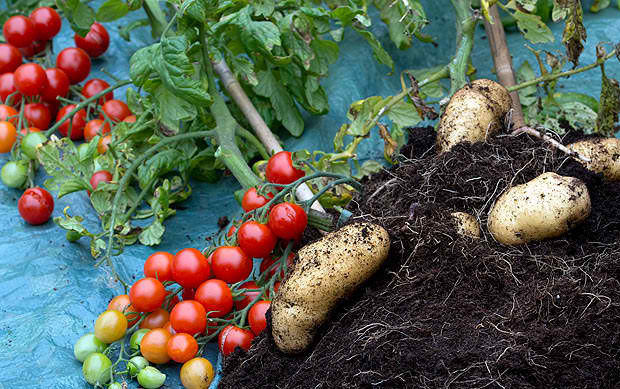I am amazed at just how evident the loss of common sense grows while people evolve too far away from their food. A pomato is not a GMO. This image above is just someone’s idea of fun. Great Photoshop skills, but the harvest from a pomato isn’t a single fresh food. It is 2 crops grown from one plant – well, actually it’s two plants in one spot propagated through grafting. For small space gardening, and growing fresh food on an apartment patio or balcony, being able to grow tomatoes and potatoes in one spot is a smart approach.
It seems that anything out of the ordinary is easily deemed genetically modified by people who know very little about gardening. Thompson Morgan thought the novelty of the pomato and it’s space-conscious benefits a great thing to make a marketing video about. Unfortunately, the people who left comments on the page are convinced that this is a new GMO atrocity. Hardly. This is no different than a Fruit Salad Tree, and much easier to propagate too. The page title on Snotr where the video is posted calls it a hybrid – but it isn’t that either. If it were the plant would produce a fruit something like that fun manipulated photo at the beginning of this post.
 This image shows a real pomato harvest. There’s no mad scientist stuff in use here at all. No species or varieties have been crossed. This isn’t about breeding something that will create havoc on the natural world. The only thing spliced together here is some stems to give you 2 harvests from one small footprint or a single container. The tomato and potato are related. They are both in the nightshade family, which makes this seemingly other worldly grafting feat a very natural joining. Still, only 40% of the people sounding off on it know what’s going on. To make matters worse, the other 60% aren’t paying any attention to what the knowledgeable folks have to say. Perhaps its overdue that more horticulture, agriculture and botany was part of required early life schooling.
This image shows a real pomato harvest. There’s no mad scientist stuff in use here at all. No species or varieties have been crossed. This isn’t about breeding something that will create havoc on the natural world. The only thing spliced together here is some stems to give you 2 harvests from one small footprint or a single container. The tomato and potato are related. They are both in the nightshade family, which makes this seemingly other worldly grafting feat a very natural joining. Still, only 40% of the people sounding off on it know what’s going on. To make matters worse, the other 60% aren’t paying any attention to what the knowledgeable folks have to say. Perhaps its overdue that more horticulture, agriculture and botany was part of required early life schooling.
This isn’t anything new, it’s just new to T&M, who saw one growing in the US on a visit. It’s cool, and provides a great solution to urban gardeners. The pomato has been around for decades.
So, how do you propagate your own pomato plants? First you need a tomato plant and a potato plant for each one you want to make. Potatoes take all season to develop well. You can theoretically harvest early for ‘new potatoes,’ but growing them this way such a harvest would destroy your tomato crop. Patience. Enjoy the tomatoes first and the potatoes in late fall.
The Thompson Morgan plant uses cherry tomatoes. Most likely this is because they begin bearing so much earlier than larger tomatoes, however, there are far better early bearing tomatoes than the cherry types. The fruits will be smaller, but with better flavor and skin that isn’t so tough. I highly recommend the heirloom Sasha Altai variety from TomatoFest.com. Great flavor, super abundant harvest of smaller fruits, and ripe in just 57 days. Don’t use store-bought potatoes! They have been treated to stop growth and will not give you a good harvest. Buy seed potatoes from an organic seed house.
The best way to learn about grafting softwood plants like the potato and tomato is by following the directions shared by the pros. The following video shows you two ways you can propagate you pomato plants (or tomtato as Thompson Morgan calls them). It doesn’t require a special type of grafting. The same methods used here by the Tomato Lab at Ohio State University for tomato grafting will work to make pomatoes too. All you need is a razor blade and some aquarium tubing to graft these plants.
By the way, if you’re not in the UK, you won’t be able to buy TomTato plants anyway. But – now you can grow your own.
Pomato